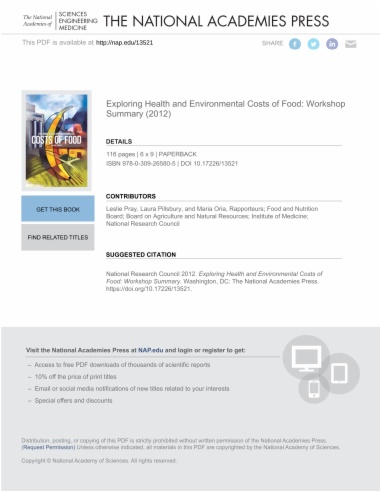

The U.S. food system provides many benefits, not the least of which is a safe, nutritious and consistent food supply. However, the same system also creates significant environmental, public health, and other costs that generally are not recognized and not accounted for in the retail price of food. These include greenhouse gas (GHG) emissions, soil erosion, air pollution, and their environmental consequences, the transfer of antibiotic resistance from food animals to human, and other human health outcomes, including foodborne illnesses and chronic disease. Some external costs which are also known as externalities are accounted for in ways that do not involve increasing the price of food. But many are not. They are borne involuntarily by society at large. A better understanding of external costs would help decision makers at all stages of the life cycle to expand the benefits of the U.S. food system even further. The Institute of Medicine (IOM) and the National Research Council (NRC) with support from the U.S. Centers for Disease Control and Prevention (CDC) convened a public workshop on April 23-23, 2012, to explore the external costs of food, methodologies for quantifying those costs, and the limitations of the methodologies.
The workshop was intended to be an information-gathering activity only. Given the complexity of the issues and the broad areas of expertise involved, workshop presentations and discussions represent only a small portion of the current knowledge and are by no means comprehensive. The focus was on the environmental and health impacts of food, using externalities as a basis for discussion and animal products as a case study. The intention was not to quantify costs or benefits, but rather to lay the groundwork for doing so. A major goal of the workshop was to identify information sources and methodologies required to recognize and estimate the costs and benefits of environmental and public health consequences associated with the U.S. food system. It was anticipated that the workshop would provide the basis for a follow-up consensus study of the subject and that a central task of the consensus study will be to develop a framework for a full-scale accounting of the environmental and public health effects for all food products of the U.S. food system.
Exploring Health and Environmental Costs of Food: Workshop Summary provides the basis for a follow-up planning discussion involving members of the IOM Food and Nutrition Board and the NRC Board on Agriculture and Natural Resources and others to develop the scope and areas of expertise needed for a larger-scale, consensus study of the subject.